How to change TabbedPage Icon when the tab is reselected in Android?
I have an application using Xamarin Forms TabbedPage which has a feature that would allow the user to pause and play a page. Please see the code below.
Shared Code
public partial class MainPage : TabbedPage
{
public MainPage()
{
InitializeComponent();
var homePage = new NavigationPage(new HomePage())
{
Title = "Home",
Icon = "ionicons_2_0_1_home_outline_25.png"
};
var phrasesPage = new NavigationPage(new PhrasesPage())
{
Title = "Play",
Icon = "ionicons_2_0_1_play_outline_25.png"
};
Children.Add(homePage);
Children.Add(phrasesPage);
}
}
In iOS renderer:
public class TabbedPageRenderer : TabbedRenderer
{
private MainPage _page;
protected override void OnElementChanged(VisualElementChangedEventArgs e)
{
base.OnElementChanged(e);
var tabbarController = (UITabBarController)this.ViewController;
if (null != tabbarController)
{
tabbarController.ViewControllerSelected += OnTabBarReselected;
}
}
void OnTabBarReselected(object sender, UITabBarSelectionEventArgs e)
{
var tabs = Element as TabbedPage;
var playTab = tabs.Children[4];
if (TabBar.SelectedItem.Title == "Play") {
if (tabs != null)
{
playTab.Title = "Pause";
playTab.Icon = "ionicons_2_0_1_pause_outline_22.png";
}
App.pauseCard = false;
}
else {
if (tabs != null) {
playTab.Title = "Play";
playTab.Icon = "ionicons_2_0_1_play_outline_25.png";
}
App.pauseCard = true;
}
}
Android Renderer
public class MyTabbedPageRenderer: TabbedPageRenderer, TabLayout.IOnTabSelectedListener
{
if (e.PropertyName == "Renderer")
{
viewPager = (ViewPager)ViewGroup.GetChildAt(0);
tabLayout = (TabLayout)ViewGroup.GetChildAt(1);
setup = true;
ColorStateList colors = null;
if ((int)Build.VERSION.SdkInt >= 23)
{
colors = Resources.GetColorStateList(Resource.Color.icon_tab, Forms.Context.Theme);
}
else
{
colors = Resources.GetColorStateList(Resource.Color.icon_tab);
}
for (int i = 0; i < tabLayout.TabCount; i++)
{
var tab = tabLayout.GetTabAt(i);
var icon = tab.Icon;
if (icon != null)
{
icon = Android.Support.V4.Graphics.Drawable.DrawableCompat.Wrap(icon);
Android.Support.V4.Graphics.Drawable.DrawableCompat.SetTintList(icon, colors);
}
}
}
void TabLayout.IOnTabSelectedListener.OnTabReselected(TabLayout.Tab tab)
{
var tabs = Element as TabbedPage;
var playTab = tabs.Children[4];
var selectedPosition = tab.Position;
if(selectedPosition == 4)
{
if (playTab.Title == "Play")
{
if (tabs != null)
{
playTab.Title = "Pause";
playTab.Icon = "ionicons_2_0_1_pause_outline_22.png";
}
App.pauseCard = false;
}
else
{
if (tabs != null)
{
playTab.Title = "Play";
playTab.Icon = "ionicons_2_0_1_play_outline_25.png";
}
App.pauseCard = true;
}
}
}
}
This is perfectly working in iOS. But somehow in Android only the Title would change but not the Icon. Anyone knows what Im missing or how it should be done? Also, is this possible to be done in the shared code instead of repeating almost exactly the same lines on code in each platform?
5 个答案:
答案 0 :(得分:5)
Custom Renderer,您可以直接在共享代码中更改Title和Icon。
只需在CurrentPageChanged
TabbedPage个活动即可
完整代码
public partial class TabbedPage1 : TabbedPage
{
NavigationPage homePage;
NavigationPage phrasesPage;
public TabbedPage1 ()
{
InitializeComponent();
var homePage = new NavigationPage(new Page1())
{
Title = "Home",
Icon = "1.png"
};
var phrasesPage = new NavigationPage (new Page2())
{
Title = "Play",
Icon = "1.png"
};
Children.Add(homePage);
Children.Add(phrasesPage);
this.CurrentPageChanged += (object sender, EventArgs e) => {
var i = this.Children.IndexOf(this.CurrentPage);
if (i == 0)
{
homePage.Title = "HomeChanged";
homePage.Icon = "2.png";
}
else {
phrasesPage.Title = "PlayChanged";
phrasesPage.Icon = "2.png";
}
};
}
}
结果
PS:从不同平台访问图像文件。
iOS - Resources
Android - Resources->drawable
答案 1 :(得分:4)
您可以使用OnTabReselected中TabRenderer参数中正在传递给您的标签来执行此操作。
您可以使用此对象移动整个逻辑。
这是我的整个渲染器文件(Android):
[assembly: ExportRenderer(typeof(SWTabSelection.MainPage), typeof(SWTabSelection.Droid.MyTabbedPageRenderer))]
namespace SWTabSelection.Droid
{
public class MyTabbedPageRenderer : TabbedPageRenderer, TabLayout.IOnTabSelectedListener
{
private ViewPager viewPager;
private TabLayout tabLayout;
private bool setup;
public MyTabbedPageRenderer() { }
public MyTabbedPageRenderer(Context context) : base(context)
{
//Use this constructor for newest versions of XF saving the context parameter
// in a field so it can be used later replacing the Xamarin.Forms.Forms.Context which is deprecated.
}
protected override void OnElementPropertyChanged(object sender, PropertyChangedEventArgs e)
{
base.OnElementPropertyChanged(sender, e);
if (e.PropertyName == "Renderer")
{
viewPager = (ViewPager)ViewGroup.GetChildAt(0);
tabLayout = (TabLayout)ViewGroup.GetChildAt(1);
setup = true;
ColorStateList colors = GetTabColor();
for (int i = 0; i < tabLayout.TabCount; i++)
{
var tab = tabLayout.GetTabAt(i);
SetTintColor(tab, colors);
}
}
}
void TabLayout.IOnTabSelectedListener.OnTabReselected(TabLayout.Tab tab)
{
// To have the logic only on he tab on position 1
if(tab == null || tab.Position != 1)
{
return;
}
if(tab.Text == "Play")
{
tab.SetText("Pause");
tab.SetIcon(Resource.Drawable.ionicons_2_0_1_pause_outline_25);
App.pauseCard = false;
}
else
{
tab.SetText("Play");
tab.SetIcon(Resource.Drawable.ionicons_2_0_1_play_outline_25);
App.pauseCard = true;
}
SetTintColor(tab, GetTabColor());
}
void SetTintColor(TabLayout.Tab tab, ColorStateList colors)
{
var icon = tab?.Icon;
if(icon != null)
{
icon = Android.Support.V4.Graphics.Drawable.DrawableCompat.Wrap(icon);
Android.Support.V4.Graphics.Drawable.DrawableCompat.SetTintList(icon, colors);
}
}
ColorStateList GetTabColor()
{
return ((int)Build.VERSION.SdkInt >= 23)
? Resources.GetColorStateList(Resource.Color.icon_tab, Forms.Context.Theme)
: Resources.GetColorStateList(Resource.Color.icon_tab);
}
}
}
我对上面的代码唯一的看法是图标没有采用Tint颜色,因此创建了一个函数,其逻辑与设置Tint相同,我在Tab Reselection上使用它。如果您的应用中只有一个标签,则可以在Android主题/样式xml中设置全局色调。
希望这有帮助。
答案 2 :(得分:3)
没有办法检测何时在Xamarin.Forms中重新选择制表符,因此我们必须使用自定义重新存档来检测逻辑。
对于Android,我们必须处理两种情况:当前标签页已更改,当前标签页已重新选择。
我们将订阅CurrentPageChanged,并在其EventHandler中,我们会检查所选的标签是否为PhrasesPage。如果是,我们将更新图标/文字。
在OnTabReselected中,我们可以查看当前选择的页面,如果它是PhrasesPage,我们可以更新PhrasesPage.Icon和PhrasesPage.Text。
示例应用
https://github.com/brminnick/ChangeTabbedPageIconSample/tree/master
Android自定义渲染器
[assembly: ExportRenderer(typeof(MainPage), typeof(TabbedPageRenderer))]
namespace YourNameSpace
{
public class TabbedPageRenderer : TabbedRenderer, TabLayout.IOnTabSelectedListener
{
//Overloaded Constructor required for Xamarin.Forms v2.5+
public TabbedPageRenderer(Android.Content.Context context) : base(context)
{
}
protected override void OnElementChanged(ElementChangedEventArgs<TabbedPage> e)
{
base.OnElementChanged(e);
Element.CurrentPageChanged += HandleCurrentPageChanged;
}
void HandleCurrentPageChanged(object sender, EventArgs e)
{
var currentNavigationPage = Element.CurrentPage as NavigationPage;
if (!(currentNavigationPage.RootPage is PhrasesPage))
return;
var tabLayout = (TabLayout)ViewGroup.GetChildAt(1);
for (int i = 0; i < tabLayout.TabCount; i++)
{
var currentTab = tabLayout.GetTabAt(i);
var currentTabText = currentTab.Text;
if (currentTabText.Equals("Play") || currentTabText.Equals("Pause"))
{
Device.BeginInvokeOnMainThread(() => UpdateTab(currentTabText, currentTab, currentNavigationPage));
break;
}
}
}
void TabLayout.IOnTabSelectedListener.OnTabReselected(TabLayout.Tab tab)
{
System.Diagnostics.Debug.WriteLine("Tab Reselected");
var mainPage = Application.Current.MainPage as MainPage;
var currentNavigationPage = mainPage.CurrentPage as NavigationPage;
if(currentNavigationPage.RootPage is PhrasesPage)
Device.BeginInvokeOnMainThread(() => UpdateTab(currentNavigationPage.Title, tab, currentNavigationPage));
}
void UpdateTab(string currentTabText, TabLayout.Tab tab, NavigationPage currentNavigationPage)
{
if (currentTabText.Equals("Puzzle"))
{
tab.SetIcon(IdFromTitle("Settings", ResourceManager.DrawableClass));
currentNavigationPage.Title = "Settings";
}
else
{
tab.SetIcon(IdFromTitle("Puzzle", ResourceManager.DrawableClass));
currentNavigationPage.Title = "Puzzle";
}
}
int IdFromTitle(string title, Type type)
{
string name = System.IO.Path.GetFileNameWithoutExtension(title);
int id = GetId(type, name);
return id;
}
int GetId(Type type, string memberName)
{
object value = type.GetFields().FirstOrDefault(p => p.Name == memberName)?.GetValue(type)
?? type.GetProperties().FirstOrDefault(p => p.Name == memberName)?.GetValue(type);
if (value is int)
return (int)value;
return 0;
}
}
}
答案 3 :(得分:0)
我认为您使用自定义渲染进行选项卡式页面自定义。对于Android,您应该参考Resource.Drawable中的图标。请尝试使用android渲染器中的以下代码段。
public class CustomTabRenderer: TabbedRenderer
{
private Activity _act;
protected override void OnModelChanged(VisualElement oldModel, VisualElement newModel)
{
base.OnModelChanged(oldModel, newModel);
_act = this.Context as Activity;
}
// You can do the below function anywhere.
public override void OnWindowFocusChanged(bool hasWindowFocus)
{
ActionBar actionBar = _act.ActionBar;
if (actionBar.TabCount > 0)
{
Android.App.ActionBar.Tab tabOne = actionBar.GetTabAt(0);
tabOne.SetIcon(Resource.Drawable.shell);
}
base.OnWindowFocusChanged(hasWindowFocus);
}
}
另请参阅:https://forums.xamarin.com/discussion/17654/tabbedpage-icons-not-visible-android
答案 4 :(得分:0)
尝试将此代码添加到OnElementChanged
TabbedPageRenderer
if (e.PropertyName == "Renderer")
{
ViewPager pager = (ViewPager)ViewGroup.GetChildAt(0);
TabLayout layout = (TabLayout)ViewGroup.GetChildAt(1);
for (int i = 0; i < layout.TabCount; i++)
{
var tab = layout.GetTabAt(i);
var icon = tab.Icon;
if (icon != null)
{
icon = Android.Support.V4.Graphics.Drawable.DrawableCompat.Wrap(icon);
Android.Support.V4.Graphics.Drawable.DrawableCompat.SetTintList(icon, colors);
}
}
}
此处有更多信息:https://montemagno.com/xamarin-forms-android-selected-and-unselected-tab-colors/
- 我写了这段代码,但我无法理解我的错误
- 我无法从一个代码实例的列表中删除 None 值,但我可以在另一个实例中。为什么它适用于一个细分市场而不适用于另一个细分市场?
- 是否有可能使 loadstring 不可能等于打印?卢阿
- java中的random.expovariate()
- Appscript 通过会议在 Google 日历中发送电子邮件和创建活动
- 为什么我的 Onclick 箭头功能在 React 中不起作用?
- 在此代码中是否有使用“this”的替代方法?
- 在 SQL Server 和 PostgreSQL 上查询,我如何从第一个表获得第二个表的可视化
- 每千个数字得到
- 更新了城市边界 KML 文件的来源?

